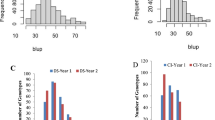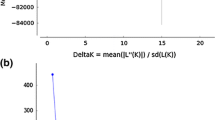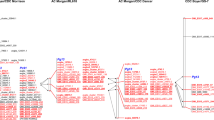Abstract
Key message
Six QTLs of resistance to sugarcane orange rust were identified in modern interspecific hybrids by GWAS. For five of them, the resistance alleles originated from S. spontaneum. Altogether, they efficiently predict disease resistance.
Abstract
Sugarcane orange rust (SOR) is a threatening emerging disease in many sugarcane industries worldwide. Improving the genetic resistance of commercial cultivars remains the most promising solution to control this disease. In this study, an association panel of 568 modern interspecific sugarcane hybrids (Saccharum officinarum x S. spontaneum) from Réunion’s breeding program was evaluated for its resistance to SOR under natural conditions of infection. Two genome-wide association studies (GWAS) were conducted between disease reactions and 183,842 single nucleotide polymorphism (SNP) markers obtained by targeted genotyping-by-sequencing. Five resistance quantitative trait loci (QTLs), named Oru1, Oru2, Oru3, Oru4 and Oru5, were identified using a single-locus GWAS (SL-GWAS). These five QTLs all originated from the species S. spontaneum. A multi-locus GWAS (ML-GWAS) uncovered an additional but less significant resistance QTL named Oru6, which originated from S. officinarum. All six QTLs had a moderate to major phenotypic effect on disease resistance. Prediction accuracy estimated with linear regression models based on each of the five QTLs identified by SL-GWAS was between 0.16-0.41. Altogether, these five QTLs provided a relatively high prediction accuracy of 0.60. In comparison, accuracies obtained with six genome-wide prediction models (i.e., GBLUP, Bayes-A, Bayes-B, Bayes-C, Bayesian Lasso and RKHS) reached only 0.65. The good prediction accuracy of disease resistance provided by the QTLs and the predominant S. spontaneum origin of their resistance alleles pave the way for effective marker-assisted breeding strategies.






Similar content being viewed by others
Data availability
Data and material available upon reasonable request to the corresponding author.
References
Abbott EV (1938) Red rot of sugarcane. Technical Bulletin No 641, USDA 96 pages.
Aitken KS (2022) History and development of molecular markers for sugarcane breeding. Sugar Tech 24(1):341–353. https://doi.org/10.1007/s12355-021-01000-7
Benjamini Y, Yekutieli D (2001) The control of the false discovery rate in multiple testing under dependency. Ann Stat 29:1165–1188
Burbano RC, da Silva MF, Coutinho AE, Gonçalves MC, dos Anjos IA, Anjos LO, Perecin D, Pinto LR (2022) Marker-trait association for resistance to sugarcane mosaic virus (SCMV) in a Sugarcane (Saccharum spp) panel. Sugar Tech 24(6):1832–1844
Chaulagain B, Raid RN, Dufault N, van Santen E, Rott P (2019a) Application timing of fungicides for the management of sugarcane orange rust. Crop Prot 119:141–146. https://doi.org/10.1016/j.cropro.2019.01.007
Chaulagain B, Dufault N, Raid RN, Rott P (2019b) Sensitivity of two sugarcane rust fungi to fungicides in urediniospore germination and detached leaf bioassays. Crop Prot 117:86–93. https://doi.org/10.1016/j.cropro.2018.11.014
Chaulagain B, Small IM, Shine JM Jr, Fraisse CW, Raid RN, Rott P (2020) Weather-based predictive modeling of orange rust of sugarcane in Florida. Phytopathology 110(3):626–632. https://doi.org/10.1094/PHYTO-06-19-0211-R
Comstock JC, Miller JD, Schnell RJ (2001) Incidence of sugarcane yellow leaf virus in clones maintained in the world collection of sugarcane and related grasses at the United States national repository in Miami, Florida. Sugar Tech 3:128–133. https://doi.org/10.1007/BF02956805
Costet L, Le Cunf L, Royaert S, Raboin L-M, Hervouet C, Toubi L, Telismart H, Garsmeur O, Rousselle Y, Pauquet J, Nibouche S, Glaszmann JC, Hoarau JY, D’Hont A (2012) Haplotype structure around Bru1 reveals a narrow genetic basis for brown rust resistance in modern sugarcane cultivars. Theor Appl Genet 125:825–836. https://doi.org/10.1007/s00122-012-1875-x
Cullis BR, Smith AB, Coombes NE (2006) On the design of early generation variety trials with correlated data. J Agric Biol Environ Stat 11:381–393. https://doi.org/10.1198/108571106X154443
D’Hont A, Garsmeur O, Piperidis N (2023) Sugarcane genome architecture revealed by chromosome-specific probes, implication for chromosome nomenclature. Proc Int Soc Sugar Cane Technol 31:266–273
D’Hont A, Grivet L, Feldmann P, Rao S, Berding N, Glaszman JC (1996) Characterisation of the double genome structure of modern sugarcane cultivars (Saccharum spp.) by molecular cytogenetics. Molec Gen Genet 250:405–413. https://doi.org/10.1007/BF02174028
De Bakker PI, Ferreira MA, Jia X, Neale BM, Raychaudhuri S, Voight BF (2008) Practical aspects of imputation-driven meta-analysis of genome-wide association studies. Hum Mol Genet 17(R2):R122–R128. https://doi.org/10.1093/hmg/ddn288
Debibakas S, Rocher S, Garsmeur O, Toubi L, Roques D, D’Hont A, Hoarau JY, Daugrois JH (2014) Prospecting sugarcane resistance to sugarcane yellow leaf virus by genome wide association. Theor Appl Genet 127:1719–1732. https://doi.org/10.1007/s00122-014-2334-7
DePristo MA, Banks E, Poplin R, Garimella KV, Maguire JR, Hartl C et al (2011) A framework for variation discovery and genotyping using next-generation DNA sequencing data. Nat Genet 43(5):491–498. https://doi.org/10.1038/ng.806
Dijoux J, Dumont T, Paysan M, Legrand C, Hervouet C, Barau L, Rott P, Hoarau JY (2023) Effects of orange rust on sugarcane yield traits in a multi-environment breeding program. Euphytica 219:49. https://doi.org/10.1007/s10681-023-03177-2
Dumont T, Thong-Chane A, Barau L, Siegmund B, Hoarau JY (2019) Genetic variabilities and genetic gains for yield components in regional sugarcane breeding programmes on Réunion Island. Sugar Tech 21:868–878. https://doi.org/10.1007/s12355-019-00718-9
Dumont T, Barau L, Thong-Chane A, Dijoux J, Mellin M, Daugrois J, Hoarau JY (2022) Sugarcane breeding in reunion: challenges, achievements and future prospects. Sugar Tech 24:181–192. https://doi.org/10.1007/s12355-021-00998-0
Garsmeur O, Droc G, Antonise R, Grimwood J, Potier B, Aitken K et al (2018) A mosaic monoploid reference sequence for the highly complex genome of sugarcane. Nat Commun 9(1):2638. https://doi.org/10.1038/s41467-018-05051-5
Geibel J, Reimer C, Weigend S, Weigend A, Pook T, Simianer H (2021) How array design creates SNP ascertainment bias. PLoS ONE 16(3):e0245178. https://doi.org/10.1371/journal.pone.0245178
Gianola D, Fernando RL, Stella A (2006) Genomic-assisted prediction of genetic value with semiparametric procedures. Genetics 173:1761–1776. https://doi.org/10.1534/genetics.105.049510
Gopi R, Chandran K, Viswanathan R, Mahendran B, Nisha M, Jayaraman S, Mayalekshmi (2023) Diseases and reaction of clones of Saccharum spontaneum and Erianthus spp. of the world collection of sugarcane germplasm. Australas Plant Pathol. https://doi.org/10.1007/s13313-023-00928-6
Grisham MP, Burner DM, Legendre BL (1992) Resistance to the H strain of sugarcane mosaic virus among wild forms of sugarcane and relatives. Plant Dis 76(4):360–362
Guilly S, Dumont T, Thong-Chane A, Barau L, Hoarau JY (2017) Analysis of multienvironment trials (MET) in the sugarcane breeding program of Reunion Island. Euphytica 213:213. https://doi.org/10.1007/s10681-017-1994-1
Hale AL, Hoy JW, Veremis JC (2010) Identification of sources of resistance to sugarcane red rot. Proc Int Soc Sugar Cane Technol 27:1–8
Hoarau JY, Souza G, D’Hont A, Menossi M, Pinto LR, Souza AP, Grivet L, Menck CFM, Ulian EC, Vincentz M (2007) Sugarcane, a tropical crop with a highly complex genome. In: Morot-Gaudry JF, Lea P, Briat JF (eds) Functional plant Genomics (Vol I, 1st End). INRA, France, Enfield Science Publishers, Enfield, pp 481–499
Hoarau JY, Dumont T, Wei X, Jackson P, D’hont A (2022) Applications of quantitative genetics and statistical analyses in sugarcane breeding. Sugar Tech 24(1):320–340. https://doi.org/10.1007/s12355-021-01012-3
Islam MS, McCord PH, Olatoye MO, Qin L, Sood S, Lipka AE, Todd JR (2021) Experimental evaluation of genomic selection prediction for rust resistance in sugarcane. Plant Genome 14(3):e20148. https://doi.org/10.1002/tpg2.20148
Khanna A, Larson DE, Srivatsan SN, Mosior M, Abbott TE, Kiwala S et al (2021) Bam-readcount-rapid generation of basepair-resolution sequence metrics. ArXiv. PMID: 34341766
Komor E (2011) Susceptibility of sugarcane, plantation weeds and grain cereals to infection by Sugarcane yellow leaf virus and selection by sugarcane breeding in Hawaii. Eur J Plant Pathol 129:379–388. https://doi.org/10.1007/s10658-010-9701-2
Kozak M, Piepho HP (2018) What’s normal anyway? Residual plots are more telling than significance tests when checking ANOVA assumptions. J Agron Crop Sci 204(1):86–98. https://doi.org/10.1111/jac.12220
Laporte F, Charcosset A, Mary-Huard T (2022) Efficient ReML inference in variance component mixed models using a Min-Max algorithm. PLoS Comput Biol 18(1):e1009659. https://doi.org/10.1371/journal.pcbi.1009659
Li H (2013) Aligning sequence reads, clone sequences and assembly contigs with BWA-MEM. arXiv preprint arXiv:1303.3997
Littell RC, Milliken GA, Stroup WW, Wolfnger RD, Schabenberger O (2006) SAS for mixed models, 2nd edn. SAS Institute Inc., Cary
Lorenz AJ, Chao S, Asoro FG, Heffner EL, Hayashi T, Iwata H, Smith KP, Sorrells ME, Jannink JL (2011) Genomic selection in plant breeding: knowledge and prospects. Adv Agron 110:77–123. https://doi.org/10.1016/B978-0-12-385531-2.00002-5
Lu YH, D’Hont A, Walker DIT, Rao PS, Feldmann P, Glaszmann JC (1994) Relationships among ancestral species of sugarcane revealed with RFLP using single copy maize nuclear probes. Euphytica 78:7–18. https://doi.org/10.1007/BF00021393
Luan T, Woolliams JA, Lien S, Kent M, Svendsen M, Meuwissen THE (2009) The accuracy of genomic selection in Norwegian red cattle assessed by cross validation. Genetics 183(3):1119–1126. https://doi.org/10.1534/genetics.109.107391
Magarey RC, Croft BJ, Willcox TG (2001) An epidemic of orange rust on sugarcane in Australia. Proc Int Soc Sugar Cane Technol 24:410–416
Magarey RC, Staier T, & Willcox TG (2002) Fungicides for control of orange rust in the 2001 Queensland crop. In: Proceedings of the 2002 Conference of the Australian Society of Sugar Cane Technologists held at Cairns, PK Editorial Services Pty Ltd, Queensland, Australia
Magarey RC (2000) Orange rust. In: Rott P, Bailey RA, Comstock JC, Croft BJ, Saumtally S (ed) A guide to sugarcane diseases, pp 121–125
Mangin B, Siberchicot A, Nicolas S, Doligez A, This P, Cierco-Ayrolles C (2012) Novel measures of linkage disequilibrium that correct the bias due to population structure and relatedness. Heredity 108(3):285–291. https://doi.org/10.1038/hdy.2011.73
McCord P, Glynn N, Comstock J (2019) Identifying markers for resistance to sugarcane orange rust (Puccinia kuehnii) via selective genotyping and capture sequencing. Euphytica 215:1–14. https://doi.org/10.1007/s10681-019-2340-6
Meuwissen T, Hayes B, Goddard M (2001) Prediction of total genetic value using genome-wide dense marker maps. Genetics 157:1819–1829. https://doi.org/10.1093/genetics/157.4.1819
O’Connell A, Deo J, Deomano E, Wei X, Jackson P, Aitken KS, Manimekalai R, Mohanraj K, Hemaprabha G, Ram B, Viswanathan R, Lakshmanan P (2022) Combining genomic selection with genome-wide association analysis identified a large effect QTL and improved selection for red rot resistance in sugarcane. Front Plant Sci 13:1021182. https://doi.org/10.3389/fpls.2022.1021182
Park T, Casella G (2008) The Bayesian Lasso. J Am Stat Assoc 103:681–686. https://doi.org/10.1198/016214508000000337
Paterson AH, Bowers JE, Bruggmann R, Dubchak I, Grimwood J, Gundlach H, Rokhsar DS (2009) The Sorghum bicolor genome and the diversification of grasses. Nature 457(7229):551–556. https://doi.org/10.1038/nature07723
Pérez P, de Los CG (2014) Genome-wide regression and prediction with the BGLR statistical package. Genetics 198(2):483–495. https://doi.org/10.1534/genetics.114.164442
Piperidis N, D’Hont A (2020) Sugarcane genome architecture decrypted with chromosome-specific oligo probes. Plant J 103(6):2039–2051. https://doi.org/10.1111/tpj.14881
Piperidis G, Piperidis N, D’Hont A (2010) Molecular cytogenetic investigation of chromosome composition and transmission in sugarcane. Mol Genet Genom 284:65–73. https://doi.org/10.1007/s00438-010-0546-3
Price AL, Zaitlen NA, Reich D, Patterson N (2010) New approaches to population stratification in genome-wide association studies. Nat Rev Genet 11(7):459–463. https://doi.org/10.1038/nrg2813
Roach BT (1972) Nobilisation of sugarcane. Proc Int Soc Sugar Cane Technol 14:206–216
Rodríguez-Álvarez MX, Boer MP, van Eeuwijk FA, Eilers PH (2018) Correcting for spatial heterogeneity in plant breeding experiments with P-splines. Spat Stat 23:52–71. https://doi.org/10.1016/j.spasta.2017.10.003
Rott P, Sood S, Comstock JC, Raid RN, Glynn NC, Gilbert RA, Sandhu HS (2017) Sugarcane orange rust. Agronomy Department. UF/IFAS Extension. SS-AGR-378 https://edis.ifas.ufl.edu/sc099
Rutherford RS (2018) Progress in understanding fungal diseases affecting sugarcane: rusts. In: Rott P (ed) Achieving Sustainable Cultivation of Sugarcane, vol 2. Breeding. Pests and Disease, Burleigh Dodds Science Publishing, Cambridge, UK, pp 245–284
Sanjel S, Chaulagain B, Small IM, Comstock JC, Hincapie M, Raid RN, Rott P (2019) Comparison of progress of brown rust and orange rust and conditions conducive for severe epidemic development during the sugarcane crop season in Florida. Plant Dis 103(5):825–831. https://doi.org/10.1094/PDIS-05-18-0862-RE
Segura V, Vilhjálmsson BJ, Platt A, Korte A, Seren Ü, Long Q, Nordborg M (2012) An efficient multi-locus mixed-model approach for genome-wide association studies in structured populations. Nat Genet 44(7):825–830. https://doi.org/10.1038/ng.2314
Selvi A, Nair NV, Balasundaram N, Mohapatra T (2003) Evaluation of maize microsatellite markers for genetic diversity analysis and fingerprinting in sugarcane. Genome 46(3):394–403. https://doi.org/10.1139/g03-018
Singh RK, Banerjee N, Khan MS et al (2016) Identification of putative candidate genes for red rot resistance in sugarcane (Saccharum species hybrid) using LD-based association mapping. Mol Genet Genom 291:1363–1377. https://doi.org/10.1007/s00438-016-1190-3
VanRaden PM (2008) Efficient methods to compute genomic predictions. J Dairy Sci 91(11):4414–4423. https://doi.org/10.3168/jds.2007-0980. (PMID: 18946147)
Vitrac M, Teai T, Goebel FR, Shilitouzi I (2019) Noble sugarcanes and modern cultivars in tahiti relative to organic rum production: description and key characteristics. Agrofor-Int J. https://doi.org/10.7251/AGRENG1902020V
Wang SB, Feng JY, Ren WL, Huang B, Zhou L, Wen YJ, Zhang J, Dunwell JM, Xu S, Zhang YM (2016) Improving power and accuracy of genome-wide association studies via a multi-locus mixed linear model methodology. Sci Rep 6(1):19444. https://doi.org/10.1038/srep19444
Wei X, Jackson PA, McIntyre CL, Aitken KS, Croft B (2006) Associations between DNA markers and resistance to diseases in sugarcane and effects of population substructure. Theor Appl Genet 114:155–164. https://doi.org/10.1007/s00122-006-0418-8
Yang X, Islam MS, Sood S, Maya S, Hanson EA, Comstock J, Wang J (2018) Identifying quantitative trait loci (QTLs) and developing diagnostic markers linked to orange rust resistance in sugarcane (Saccharum spp.). Front Plant Sci 9:350. https://doi.org/10.3389/fpls.2018.00350
Yang X, Sood S, Luo Z, Todd J, Wang J (2019) Genome-wide association studies identified resistance loci to orange rust and yellow leaf virus diseases in sugarcane (Saccharum spp.). Phytopathology 109(4):623–631. https://doi.org/10.1094/PHYTO-08-18-0282-R
Zhang J, Zhang X, Tang H, Zhang Q, Hua X, Ma X et al (2018) Allele-defined genome of the autopolyploid sugarcane Saccharum spontaneum L. Nat Genet 50(11):1565–1573. https://doi.org/10.1038/s41588-018-0237-2
Zhang Q, Qi Y, Pan H et al (2022) Genomic insights into the recent chromosome reduction of autopolyploid sugarcane Saccharum spontaneum. Nat Genet 54:885–896. https://doi.org/10.1038/s41588-022-01084-1
Zhao D, Glynn NC, Glaz B, Comstock JC, Sood S (2011) Orange rust effects on leaf photosynthesis and related characters of sugarcane. Plant Dis 95:640–647. https://doi.org/10.1094/PDIS-10-10-0762
Acknowledgements
The authors wish to thank the technical staff members of eRcane (F. Poiny, D. Vaitilingom, A. Corre, G. Morel and C. Sautron) for the management of the field experiments. The participation of M. Paysan and C. Legrand in disease assessment in the sugarcane fields is also highly appreciated. The authors also wish to thank M. Vitrac for providing some of the S. officinarum accessions.
Funding
This work was funded by the company eRcane through the AGIV project and by ANRT (Association Nationale de la Recherche et de la Technologie) through the CIFRE PhD grant N° 2021/0634 of J. Dijoux.
Author information
Authors and Affiliations
Contributions
JD, JYH, LB, PR and TD designed the phenotyping methodology. JD, JYH and TD acquired the phenotypic data. JD, JYH, SR and TD performed statistical analyses of the phenotypic data. CH performed Bru 1 diagnoses and prepared the DNA samples. OG and SR pre-treated raw sequencing data. JD, JYH and SR performed association studies and genomic prediction analyses. JYH conceived and supervised the AGIV project. JYH, ADH and PR supervised JD’s PhD. LB supervised the technical management of the experiments. JD, JYH, SR and TD wrote the original draft. ADH, OG and PR reviewed and edited the manuscript. All authors have read and approved the manuscript.
Corresponding author
Ethics declarations
Conflict of interest
On behalf of all authors, the corresponding author states that there is no conflict of interest.
Additional information
Communicated by Lee Hickey.
Publisher’s Note
Springer Nature remains neutral with regard to jurisdictional claims in published maps and institutional affiliations.
Supplementary Information
Below is the link to the electronic supplementary material.
Rights and permissions
Springer Nature or its licensor (e.g. a society or other partner) holds exclusive rights to this article under a publishing agreement with the author(s) or other rightsholder(s); author self-archiving of the accepted manuscript version of this article is solely governed by the terms of such publishing agreement and applicable law.
About this article
Cite this article
Dijoux, J., Rio, S., Hervouet, C. et al. Unveiling the predominance of Saccharum spontaneum alleles for resistance to orange rust in sugarcane using genome-wide association. Theor Appl Genet 137, 81 (2024). https://doi.org/10.1007/s00122-024-04583-3
Received:
Accepted:
Published:
DOI: https://doi.org/10.1007/s00122-024-04583-3




